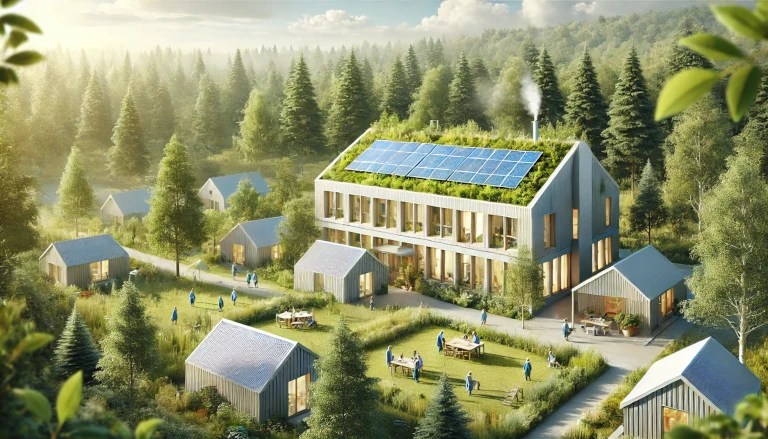With environmental challenges becoming more pressing, green schools offer a transformative model of education by integrating sustainability into infrastructure, curriculum, and daily practices. Building a model Green School in India represents a significant step toward environmental consciousness, blending academic learning with ecological responsibility. Here’s a comprehensive guide on what it takes to create a Green School in India, covering aspects such as why it’s essential, how to design it, costs, challenges, and benefits.
Why Create a Green School in India? 🌏
Green schools not only foster academic growth but also instill values of environmental stewardship and sustainability in students. As Indian cities face challenges like air pollution, water scarcity, and waste management, establishing green schools can help cultivate an environmentally responsible generation.
Key Reasons to Build a Green School:
- Environmental Impact: Reduces energy consumption and carbon emissions through sustainable architecture and practices.
- Educational Value: Provides students with a practical understanding of sustainability, preparing them for a greener future.
- Community Engagement: Green schools often engage with local communities, promoting environmental awareness and creating a ripple effect of positive change.
How to Design a Model Green School in India? 🏗️
Designing a Green School requires a holistic approach that combines eco-friendly infrastructure, sustainable practices, and a curriculum focused on environmental education. Here’s how to get started:
- Sustainable Infrastructure: Use locally sourced, eco-friendly materials such as bamboo, stone, and recycled materials for construction. Green schools often include energy-efficient features like solar panels for renewable energy, rainwater harvesting systems, and natural ventilation to reduce reliance on air conditioning.
- Energy Efficiency: Focus on passive solar design to maximize natural light and ventilation. Additionally, install LED lighting, solar-powered water heaters, and motion sensors to conserve electricity.
- Water Conservation: Incorporate rainwater harvesting and greywater recycling systems to reuse water efficiently. Building green schools in India can also include low-flow fixtures and waterless composting toilets.
- Waste Management: Establish composting stations, recycling bins, and an organic garden where students learn to compost food scraps and other biodegradable waste.
- Green Spaces and Gardens: A model Green School should have dedicated spaces for organic gardening and tree planting, allowing students to learn about local flora and agriculture.
Curriculum and Learning Approach 📘
A Green School model emphasizes a curriculum that fosters a connection with nature while teaching traditional subjects through an environmental lens. The Green School curriculum focuses on:
- Green Studies: Courses on environmental science, climate change, and conservation, enabling students to gain practical knowledge about global ecological challenges.
- Project-Based Learning: Students engage in hands-on projects, such as setting up a school compost system or maintaining a solar energy unit, which reinforce theoretical knowledge with practical applications.
- Community Projects: Encourage students to participate in community-based environmental projects, such as tree planting drives and clean-up activities, to instill a sense of responsibility toward their surroundings.
Benefits of a Model Green School 🌞
Building a Green School offers multiple advantages to students, educators, and communities, such as:
- Improved Academic Performance: Studies have shown that students in green schools perform better due to natural light, fresh air, and a healthier environment that supports learning.
- Health Benefits: With reduced exposure to toxins, better indoor air quality, and access to green spaces, students in green schools tend to have fewer respiratory issues and allergies.
- Financial Savings: While initial investments in green infrastructure may be high, green schools benefit from lower operating costs in the long term due to savings in energy, water, and waste management.
- Environmental Stewardship: By learning and practicing sustainable habits, students grow into eco-conscious adults, helping to create a greener society.
Where to Establish Green Schools in India? 🌍
Green Schools are most beneficial in urban and semi-urban areas where pollution and resource depletion are pressing issues. Cities like Delhi, Mumbai, and Bangalore can benefit significantly from green schools, but rural areas also stand to gain by integrating agricultural sustainability practices.
Ideal Locations for Green Schools:
- High-Population Urban Centers: To address pollution and resource challenges directly.
- Eco-Tourism Zones: Establishing green schools in areas known for eco-tourism can attract visitors interested in sustainable living.
- Environmentally Sensitive Zones: Locations near forests, rivers, or other natural areas can benefit from schools that emphasize conservation.
Costs Involved in Setting Up a Model Green School 💸
The initial cost of setting up a Green School is generally higher than that of traditional schools, but these investments yield long-term savings. The primary expenses include:
- Sustainable Construction: Approximately INR 20-30 lakh for a small school, depending on the materials and energy-efficient designs used.
- Renewable Energy Systems: Solar panels, rainwater harvesting, and composting toilets can add INR 10-15 lakh.
- Eco-Friendly Equipment: Smart lighting, low-flow water fixtures, and recycling facilities can add another INR 5-10 lakh.
Cost-Benefit Analysis:
- Long-Term Savings: While initial costs may be high, savings on energy and water bills can offset these costs within a few years.
- Funding Opportunities: Grants from government and environmental organizations can help fund construction and green initiatives.
Limitations and Challenges 🌐
Despite the numerous benefits, building a Green School in India comes with its own set of challenges:
- High Initial Investment: The cost of eco-friendly materials, renewable energy installations, and sustainable architecture can be a deterrent.
- Maintenance Requirements: Green infrastructure, such as solar panels and composting systems, requires regular maintenance, which can increase operational costs.
- Limited Awareness and Support: In some regions, there may be limited understanding of green initiatives, leading to a lack of community support and funding.
Paving the Way for Green Schools in India 🌱🏫
Designing a model Green School in India is a step toward nurturing an environmentally responsible generation. These schools demonstrate that education can be sustainable, both environmentally and financially. With the right combination of sustainable practices, innovative teaching methods, and community support, Green Schools have the potential to redefine the future of education in India. As more schools adopt the green model, they will play a significant role in addressing the country’s ecological challenges and promoting a more sustainable way of life.
Building a Green School in India combines education with sustainability, promoting environmental responsibility and offering long-term financial benefits. 🌍
Discover more from Green Ecosystem - Renewable Energy, Agriculture, and Environmental Sustainability
Subscribe to get the latest posts sent to your email.


